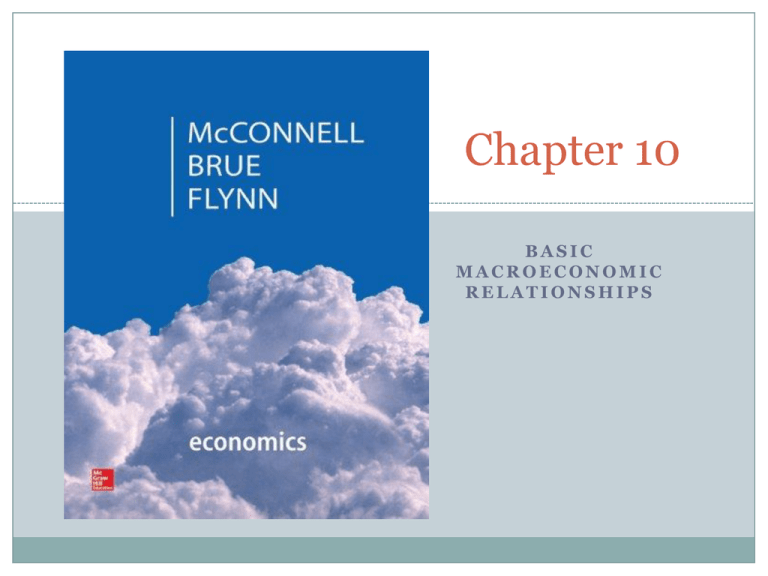
Chapter 10
BASIC
MACROECONOMIC
RELATIONSHIPS
Taylor Economics – Chapter 10
1. The size of the MPC is assumed to be:
a) less than zero.
b) greater than one.
c) greater than zero, but less than one.
d) two or more.
Copyright © Houghton Mifflin Company. All rights
reserved.
Taylor Economics – Chapter 10
1. The size of the MPC is assumed to be:
a) less than zero.
b) greater than one.
c) greater than zero, but less than one.
d) two or more.
Copyright © Houghton Mifflin Company. All rights
reserved.
Taylor Economics – Chapter 9
2. Suppose that a new machine tool having a useful
life of only one year costs $80,000. Suppose, also,
that the net additional revenue resulting from
buying this tool is expected to be $96,000. The
expected rate of return on this tool is:
a) 80 percent.
b) 8 percent.
c) 2 percent.
d) 20 percent.
Copyright © Houghton Mifflin Company. All rights
reserved.
Taylor Economics – Chapter 9
2. Suppose that a new machine tool having a useful
life of only one year costs $80,000. Suppose, also,
that the net additional revenue resulting from
buying this tool is expected to be $96,000. The
expected rate of return on this tool is:
a) 80 percent.
b) 8 percent.
c) 2 percent.
d) 20 percent.
Copyright © Houghton Mifflin Company. All rights
reserved.
Taylor Economics – Chapter 10
3. If business taxes are reduced and the real interest
rate increases:
a) consumption and saving will necessarily increase.
b) the level of investment spending might either
increase or decrease.
c) the level of investment spending will necessarily
increase.
d) the level of investment spending will necessarily
decrease.
Copyright © Houghton Mifflin Company. All rights
reserved.
Taylor Economics – Chapter 10
3. If business taxes are reduced and the real interest
rate increases:
a) consumption and saving will necessarily increase.
b) the level of investment spending might
either increase or decrease.
c) the level of investment spending will necessarily
increase.
d) the level of investment spending will necessarily
decrease.
Copyright © Houghton Mifflin Company. All rights
reserved.
Taylor Economics – Chapter 10
4. The multiplier effect means that:
a) consumption is typically several times as large as
saving.
b) a change in consumption can cause a larger
increase in investment.
c) an increase in investment can cause GDP to
change by a larger amount.
d) a decline in the MPC can cause GDP to rise by
several times that amount.
Copyright © Houghton Mifflin Company. All rights
reserved.
Taylor Economics – Chapter 10
4. The multiplier effect means that:
a) consumption is typically several times as
large as saving.
b) a change in consumption can cause a larger
increase in investment.
c) an increase in investment can cause
GDP to change by a larger amount.
d) a decline in the MPC can cause GDP to rise
by several times that amount.
Copyright © Houghton Mifflin Company. All rights
reserved.
Taylor Economics – Chapter 10
5. As disposable income decreases, consumption:
a) And saving both increase
b) And saving both decrease
c) Increases and saving decreases
d) Decreases and saving increases
Copyright © Houghton Mifflin Company. All rights
reserved.
Taylor Economics – Chapter 10
5. As disposable income decreases,
consumption:
a) And saving both increase
b) And saving both decrease
c) Increases and saving decreases
d) Decreases and saving increases
Copyright © Houghton Mifflin Company. All rights
reserved.
Taylor Economics – Chapter 10
6. If the consumption schedule shifts downward,
and the shift was not caused by a tax change, then
the saving schedule:
a) May shift either upward or downward
b) Will shift downward
c) Will shift upward
d) Will not shift
Copyright © Houghton Mifflin Company. All rights
reserved.
Taylor Economics – Chapter 10
6. If the consumption schedule shifts downward, and
the shift was not caused by a tax change, then the
saving schedule:
a) May shift either upward or downward
b) Will shift downward
c) Will shift upward
d) Will not shift
Copyright © Houghton Mifflin Company. All rights
reserved.
Taylor Economics – Chapter 10
7. Which would shift the consumption
schedule upward?
a) A decrease in wealth
b) An increase in wealth
c) Consumer expectations of falling prices
d) Consumer expectations of product
surpluses
Copyright © Houghton Mifflin Company. All rights
reserved.
Taylor Economics – Chapter 10
7. Which would shift the consumption
schedule upward?
a) A decrease in wealth
b) An increase in wealth
c) Consumer expectations of falling prices
d) Consumer expectations of product
surpluses
Copyright © Houghton Mifflin Company. All rights
reserved.
Taylor Economics – Chapter 10
8. An inverse relationship between the rate of
interest and the level of:
a) Income is suggested by the consumption
function
b) Prices is suggested by the aggregate supply
curve
c) Employment is suggested by the aggregate
demand curve
d) Investment spending is suggested by the
investment-demand curve
Copyright © Houghton Mifflin Company. All rights
reserved.
Taylor Economics – Chapter 10
8. An inverse relationship between the rate of
interest and the level of:
a) Income is suggested by the consumption
function
b) Prices is suggested by the aggregate supply
curve
c) Employment is suggested by the aggregate
demand curve
d) Investment spending is suggested by
the investment-demand curve
Copyright © Houghton Mifflin Company. All rights
reserved.
Taylor Economics – Chapter 10
9. Which would decrease investment
demand?
a) A decrease in business taxes
b) An increase in the cost of acquiring capital
goods
c) An increase in the rate of technological
change
d) A decrease in the stock of capital goods on
hand
Copyright © Houghton Mifflin Company. All rights
reserved.
Taylor Economics – Chapter 10
9. Which would decrease investment
demand?
a) A decrease in business taxes
b) An increase in the cost of acquiring
capital goods
c) An increase in the rate of technological
change
d) A decrease in the stock of capital goods on
hand
Copyright © Houghton Mifflin Company. All rights
reserved.
Taylor Economics – Chapter 10
10. Generally speaking, the greater the MPS, the:
a) Smaller would be the increase in income which
results from an increase in consumption spending
b) Larger would be the increase in income which results
from an increase in consumption spending
c) Larger would be the increase in income which results
from a decrease in consumption spending
d) Smaller would be the increase in income which
results from a decrease in consumption spending
Copyright © Houghton Mifflin Company. All rights
reserved.
Taylor Economics – Chapter 10
10. Generally speaking, the greater the MPS, the:
a) Smaller would be the increase in income
which results from an increase in
consumption spending
b) Larger would be the increase in income which
results from an increase in consumption
spending
c) Larger would be the increase in income which
results from a decrease in consumption spending
d) Smaller would be the increase in income which
results from a decrease in consumption spending
Copyright © Houghton Mifflin Company. All rights
reserved.







